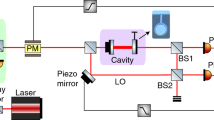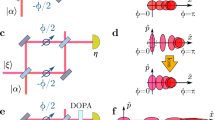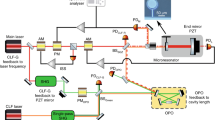Abstract
Quantum noise-limited displacement sensors such as gravitational wave detectors can be improved by using non-classical light1. This has been achieved in limited bands and in a single quadrature (that is, only one of a pair of conjugate variables) by injecting single-mode squeezed vacuum states2,3. Quantum noise in gravitational wave detectors, however, results from input noise in both quadratures, with the dominant quadrature being a function of Fourier frequency. Broadband reduction of this noise via squeezed light injection then requires a method of rotating this quadrature. This can be accomplished with a low-loss, all-pass optical filter with bandwidth in the low audio frequencies4,5, a substantial technical challenge. We present a proof-of-principle demonstration of a recent proposal6 to use two-mode squeezed vacuum states with Einstein–Podolsky–Rosen (EPR) entanglement, which allows the gravitational detector to simultaneously serve as the optical filter, eliminating the need for a separate apparatus.
This is a preview of subscription content, access via your institution
Access options
Access Nature and 54 other Nature Portfolio journals
Get Nature+, our best-value online-access subscription
$29.99 / 30 days
cancel any time
Subscribe to this journal
Receive 12 print issues and online access
$209.00 per year
only $17.42 per issue
Buy this article
- Purchase on Springer Link
- Instant access to full article PDF
Prices may be subject to local taxes which are calculated during checkout



Similar content being viewed by others
Data availability
The data that support the plots within this paper and other findings of this study are available from the corresponding author upon reasonable request.
References
Kimble, H. J., Levin, Y., Matsko, A. B., Thorne, K. S. & Vyatchanin, S. P. Conversion of conventional gravitational-wave interferometers into quantum nondemolition interferometers by modifying their input and/or output optics. Phys. Rev. D 65, 022002 (2001).
Grote, H. et al. First long-term application of squeezed states of light in a gravitational-wave observatory. Phys. Rev. Lett. 110, 181101 (2013).
The LIGO Scientific Collaboration et al. Enhanced sensitivity of the LIGO gravitational wave detector by using squeezed states of light. Nat. Photon. 7, 613–619 (2013).
Oelker, E. et al. Audio-band frequency-dependent squeezing for gravitational-wave detectors. Phys. Rev. Lett. 116, 041102 (2016).
Capocasa, E. et al. Estimation of losses in a 300 m filter cavity and quantum noise reduction in the Kagra gravitational-wave detector. Phys. Rev. D 93, 082004 (2016).
Ma, Y. et al. Proposal for gravitational-wave detection beyond the standard quantum limit through EPR entanglement. Nat. Phys. 13, 776–780 (2017).
The LIGO Scientific Collaboration. Advanced LIGO. Class. Quant. Grav. 32, 074001 (2015).
The VIRGO Collaboration. Advanced VIRGO: a second-generation interferometric gravitational wave detector. Class. Quant. Grav. 32, 024001 (2015).
The LIGO Scientific Collaboration and VIRGO Collaboration. GW170817: observation of gravitational waves from a binary neutron star inspiral. Phys. Rev. Lett. 119, 161101 (2017).
Abbott, B. P. et al. Multi-messenger observations of a binary neutron star merger. Astrophys. J. Lett. 848, L12 (2017).
Caves, C. M. Quantum-mechanical noise in an interferometer. Phys. Rev. D 23, 1693–1708 (1981).
Wade, A. R. et al. Optomechanical design and construction of a vacuum-compatible optical parametric oscillator for generation of squeezed light. Rev. Sci. Instrum. 87, 063104 (2016).
Vahlbruch, H., Mehmet, M., Danzmann, K. & Schnabel, R. Detection of 15 dB squeezed states of light and their application for the absolute calibration of photoelectric quantum efficiency. Phys. Rev. Lett. 117, 110801 (2016).
Oelker, E. et al. Ultra-low phase noise squeezed vacuum source for gravitational wave detectors. Optica 3, 682–685 (2016).
Mikhailov, E. E., Goda, K., Corbitt, T. & Mavalvala, N. Frequency-dependent squeeze-amplitude attenuation and squeeze-angle rotation by electromagnetically induced transparency for gravitational-wave interferometers. Phys. Rev. A 73, 053810 (2006).
Ma, Y. et al. Narrowing the filter-cavity bandwidth in gravitational-wave detectors via optomechanical interaction. Phys. Rev. Lett. 113, 151102 (2014).
Kwee, P., Miller, J., Isogai, T., Barsotti, L. & Evans, M. Decoherence and degradation of squeezed states in quantum filter cavities. Phys. Rev. D 90, 062006 (2014).
Evans, M., Barsotti, L., Kwee, P., Harms, J. & Miao, H. Realistic filter cavities for advanced gravitational wave detectors. Phys. Rev. D 88, 022002 (2013).
Chelkowski, S. et al. Experimental characterization of frequency-dependent squeezed light. Phys. Rev. A 71, 013806 (2005).
Brown, D. D. et al. Broadband sensitivity enhancement of detuned dual-recycled Michelson interferometers with EPR entanglement. Phys. Rev. D 96, 062003 (2017).
Südbeck, J., Steinlechner, S., Korobko, M. & Schnabel, R. Demonstration of interferometer enhancement through Einstein–Podolsky–Rosen entanglement. Nat. Photon. https://doi.org/10.1038/s41566-019-0583-3 (2020).
Hage, B., Samblowski, A. & Schnabel, R. Towards Einstein–Podolsky–Rosen quantum channel multiplexing. Phys. Rev. A 81, 062301 (2010).
Zhang, J. Einstein–Podolsky–Rosen sideband entanglement in broadband squeezed light. Phys. Rev. A 67, 054302 (2003).
Li, W., Jin, Y., Yu, X. & Zhang, J. Enhanced detection of a low-frequency signal by using broad squeezed light and a bichromatic local oscillator. Phys. Rev. A 96, 023808 (2017).
Buonanno, A. & Chen, Y. Quantum noise in second generation, signal-recycled laser interferometric gravitational-wave detectors. Phys. Rev. D 64, 042006 (2001).
Vahlbruch, H. et al. Coherent control of vacuum squeezing in the gravitational-wave detection band. Phys. Rev. Lett. 97, 011101 (2006).
Chua, S. S. Y. et al. Backscatter tolerant squeezed light source for advanced gravitational-wave detectors. Opt. Lett. 36, 4680–4682 (2011).
Beckey, J. L., Ma, Y., Boyer, V. & Miao, H. Broadband quantum noise reduction in future long baseline gravitational-wave detectors via EPR entanglement. Phys. Rev. D 100, 083011 (2019).
Takeno, Y., Yukawa, M., Yonezawa, H. & Furusawa, A. Observation of −9 dB quadrature squeezing with improvement of phase stability in homodyne measurement. Opt. Express 15, 4321–4327 (2007).
Acknowledgements
This research was supported by the Australian Research Council (ARC) under the ARC Centre of Excellence for Gravitational Wave Discovery grant number CE170100004. M.J.Y. thanks B. Buchler, G. Mansell and V. Adya for discussions.
Author information
Authors and Affiliations
Contributions
M.J.Y. performed the investigation and formal analysis. P.A. wrote the real-time data acquisition/analysis program. M.J.Y. and D.E.M. conceptualized the project. M.J.Y. wrote the original draft. P.A., T.G.M., R.L.W. and D.E.M. reviewed and edited the manuscript. P.A., T.G.M., R.L.W., B.J.J.S. and D.E.M. provided supervision.
Corresponding author
Ethics declarations
Competing interests
The authors declare no competing interests.
Additional information
Publisher’s note Springer Nature remains neutral with regard to jurisdictional claims in published maps and institutional affiliations.
Supplementary information
Supplementary Information
Supplementary Figs. 1 and 2 and methods.
Rights and permissions
About this article
Cite this article
Yap, M.J., Altin, P., McRae, T.G. et al. Generation and control of frequency-dependent squeezing via Einstein–Podolsky–Rosen entanglement. Nat. Photonics 14, 223–226 (2020). https://doi.org/10.1038/s41566-019-0582-4
Received:
Accepted:
Published:
Issue Date:
DOI: https://doi.org/10.1038/s41566-019-0582-4
This article is cited by
-
Entanglement-enhanced optomechanical sensor array with application to dark matter searches
Communications Physics (2023)
-
Resource reduction for simultaneous generation of two types of continuous variable nonclassical states
Frontiers of Physics (2021)
-
Improved squeezing of noise
Nature Photonics (2020)
-
Twin beam quantum-enhanced correlated interferometry for testing fundamental physics
Communications Physics (2020)
-
Demonstration of interferometer enhancement through Einstein–Podolsky–Rosen entanglement
Nature Photonics (2020)



